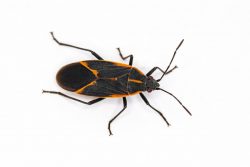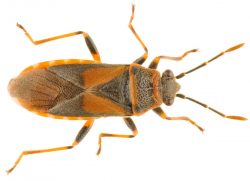How to Identify Spring Pests in Utah
By Thorn Team • Mar 30th 2022
Are you wondering how to identify spring pests in Utah? Aahhh, springtime. Nature in full bloom and pests popping up everywhere!
According to Utah State University, only around 1% of insects and mites cause harm, but it's still important to know what pests are active in your area during each season and whether they can cause damage to your home, property or belongings.

Spring is a busy time at Thorn Pest Solutions! We see a large increase in the following pests this time of year:
- Ants
- Spiders
- Box elder bugs
- Elm seed bugs
- Termites
- Wasps and bees
- Flies
Overwintering Pests Emerge in the Spring
DEFINITION: Overwintering is how pests stay alive during the wintertime. Overwintering pests spend the cold months in a variety of hiding places, some outside and some inside.
There are two times of year when you might be seeing overwintering pest activity:
- Winter when pests are looking for somewhere to hunker down.
- Spring when pests come out ready to get active, find food and reproduce.
Outside, pests overwinter in areas such as:
- Underneath dead leaves and other rotting organic matter
- Beneath the bark of trees
- Under the soil
- Woodpiles
- Between pieces of siding on the outside of the home
Inside, pests overwinter in areas like:
- Attics
- Crawlspaces
- Basements
- Storage areas and cellars
- Wall voids
Overwintering Pests Inside Your Utah Home
While most overwintering occurs outside, some overwintering pests enter homes in small, often undetectable numbers and make their way outside come spring.
When warmer weather comes, outside is where these pests want to be. Unfortunately, they don't always end up in the great outdoors; sometimes, they turn up inside.These pests likely don't pose much threat but can be a real nuisance.
SOME QUICK ADVICE FROM THORN: If overwintering pests are going to emerge inside, it's going to be on particularly warm days in the late winter/early spring, especially when warm weather arrives suddenly after a rainy or cold spell. The change in temperature signals overwintering pests that it's time to wake up and start moving.
Especially when it comes to yellowjacket queens, overwintering pests appearing inside can be alarming. Luckily, these pests are slow and lethargic as their bodies warm up and adjust to the changes in the environment.
If you are finding pests emerging in your home here or there in smaller numbers, there are a couple of things you can do:
- Open windows or doors so the accidental invader(s) can find their way outside where they belong
- Grab a vacuum and suck up occasional trespassing pests
- Run a fan or two to keep the air in your home moving and discourage emerging flies from hanging around
A Guide to Spring Pests in Utah
Having an idea of what pests may be present inside or outside your Utah home based on the time of year can help you anticipate whether the activity you are seeing will go away on its own or whether you should be proactive about getting help.
In this guide, clicking on a pest name will take you to the Thorn pest library , where you can find additional photos and identification information.
Utah Ants
How many different ants are there in Utah?
There are a variety of ant species present in the state of Utah, including:
- Pavement ants
- Carpenter ants
- Harvester ants
- Odorous house ants
- Pharoah ants
- Pyramid ants
- Field ants
- Argentine ants
- Velvety tree ants
Spring Pavement Ants in Utah
When it comes to springtime pests in Utah, pavement ants are at the top of the list.
In fact, pavement ants are the most common ant in Utah.
Pavement ants produce small mounds of dirt or sand around the entry holes that lead to their nest. Pavement ants can be particular about where they like to nest, and can be found in places such as:
- Under stone or patio slabs
- Between cracks in the pavement
- Beneath building foundations
- In the walls or below the floor of structures
SOME QUICK ADVICE FROM THORN: If it is spring and you are suddenly noticing winged ants around your property after stormy, rainy weather, these are probably pavement ant reproductives, also called winged reproductives' or swarmers.
If you are seeing them primarily outside, keep an eye on things and don't panic. This is perfectly normal springtime behavior for pavement ants, but stay on the lookout. Large numbers of pavement ants (winged or not) popping up persistently, especially inside, could be the sign of a bigger issue that may require professional help .
Spiders in Utah
Like most places in the world, there is no short supply of spiders in Utah. If you're seeing spiders around your home, it could be one of the following:Effective spider control can be tricky. Many people see spiders and their first instinct is to run for a can of spray insecticide. The problem with this? Spiders aren't insects, they're arachnids.
While there are some targeted treatments and sprays for spiders, these sprays need to come in direct contact with spiders if they're going to be lethal.
SOME QUICK ADVICE FROM THORN: Spider sprays of any kind should be applied in minimal amounts and only when absolutely necessary. As always, chemical control of pests should be used in combination with other pest control methods, especially physical removal.
While spider sprays may kill a few spiders here or there, physically removing spiders, egg sacs and webs from the outside of your home or building will help reduce the surrounding spider population long-term. With regular physical removal, as time goes on, you should see an improvement in the overall number of spiders around your property. Read more about how our HomeGuard residential pest control service works here . We'll get you spider issue under control.
Box Elder Bugs and Elm Seed Bugs
Considered nuisance pests, both box elder and elm seed bugs are incredibly common in Utah. These pests are both very similar and it can be difficult to spot their differences.
Boxelder bugs start their activity in the spring time and are active throughout the summer, but don't become a serious bother until they begin congregating in large numbers on sunny walls or heated buildings.
Elm seed bugs are new to the Utah scene as of 2014 , but that doesn't mean they aren't a bother. While similar in appearance to the boxelder bug, elm seed bug activity reaches its height mid-summer.
Both insects are nuisance pests, meaning they do not bite or cause damage, and both are related to the stink bug, meaning they release an unpleasant odor when crushed. During summer months, both box elder and elm seed bugs can be seen congregating in the sun on the outside of buildings.
Boxelder Bugs vs. Elm Seed Bugs - What's the Difference?
- Dark black-brown with red markings
- Markings are bright red or orange
- Found most during Aug - Sept

- Rusty red-brown and black markings
- Black and brown triangles on back
- Activity peaks in mid-summer

Utah Termites
There are three general types of termites found in Utah:
- Dampwood termites
- Drywood termies
- Subterranean termites
At Thorn, we most commonly treat for the Western subterranean termite .
Termites differ in appearance depending on what their job is within the colony. Winged termites are called swarmers and are responsible for reproduction. Wingless termites are either workers or soldiers. Workers and soldiers are similar in size (1/4 to 3/8 inch) and color (both are pale cream in coloring), but soldier termites have a large head and sharp pointy, pincer-like mouthparts.
SOME QUICK ADVICE FROM THORN: Not sure how to identify the swarmers you're seeing? Are they ants or termites? Look at their wings.
While both insects have two sets of wings, termite swarmers have two sets of wings that are equal in length where ants have two sets of wings that are different in length, with the forewings being longer than the hind wings.
Wasps and Bees in Utah
Considering Utah is the Beehive state , it should come as no surprise that there are a number of wasps and bees present in Utah, and it's important to know which are a threat and which are not.
Bees and wasps of Utah include:
- Honey bees
- Bumble bees
- Mason, potter and mud dauber wasps
- Baldfaced hornets
- Western yellowjacket
- Paper wasp
Of these pests, honeybees and bumblebees are beneficial pollinators, which are not aggressive and should be left alone whenever possible. They do important work!
Mason, potter and mud dauber wasps pose mild threats, but overall are not aggressive and are considered beneficial as they do not build large nests, do not cause damage and consume nuisance pests such as spiders.
Baldfaced hornets, western yellowjackets and paperwasps are all known to sting humans and should be given space. One or two found outside here and there are not a concern as they are likely foraging, but if you see a distinct flight path coming and going from one spot or you can see a visible nest, it may be time to call in the pros .
Utah Flies
Like many Utah pests, flies get excited when the warm weather arrives. You may be seeing flies inside or outside depending on the species. Flies around Utah can include:
- Blow flies (also known as bottle flies)
- House flies
- Horse and deer flies
- Black solider flies
- Crane flies
- Flesh flies
- Drain flies
- Fruit flies
- Fungus gnats
When warm weather first arrives, lethargic overwintering flies may emerge inside and be found around windowsills, or they may congregate in large numbers in the sun to warm up on the outside of buildings. Interior flies can be vacuumed up as needed, but these fly problems should resolve as the season continues.
SOME QUICK ADVICE FROM THORN: If you are having a persistent, ongoing fly issue (especially inside), it's time to start looking for sources. Flies need rotting organic matter to feed on and to lay their eggs in. Nasty, yes, but important to keep in mind when you're trying to figure out where a fly problem is coming from. Even in the cleanest of places, a dirty garbage disposal or gunky floor drain can be enough to create a fly issue.
Get Rid of Utah Pests This Spring
Whether you've noticed ongoing issues for years or you just moved into the area and you want to be proactive, Thorn can help.
Our trained IPM specialists will perform an inspection of your business or home and formulate a treatment plan specific to you and your property's needs.
Don't wait until a problem becomes serious. Get ahead of pests and reach out to us today !
About Thorn
Thorn is a Utah local pest management company. We are a QualityPro certified company which is a prestigious accreditation awarded to less than 3% of the pest management companies in the US.
Resources
About Thorn
Thorn is a Utah local pest management company. We are a QualityPro certified company which is a prestigious accreditation awarded to less than 3% of the pest management companies in the US.